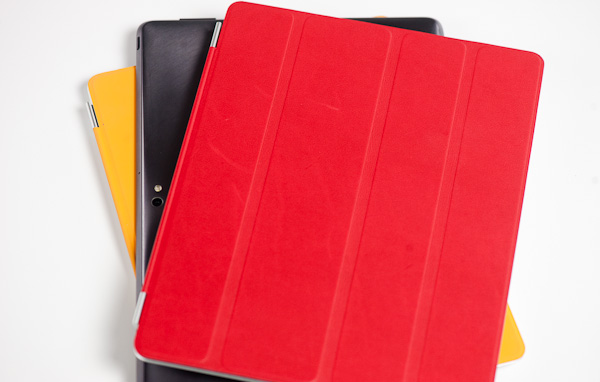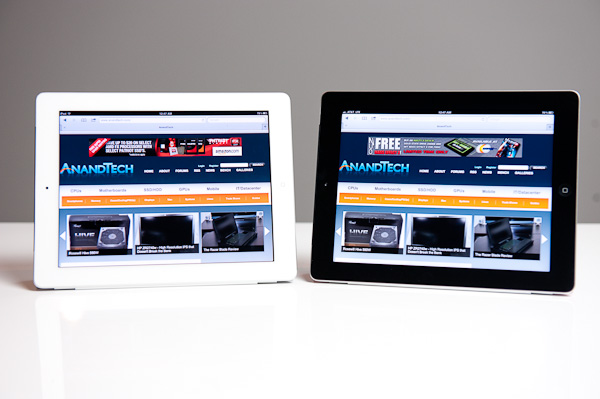The Apple iPad Review (2012)
by Vivek Gowri & Anand Lal Shimpi on March 28, 2012 3:14 PM ESTSince Apple launched the first iPad two years ago, the tablet market has evolved rapidly. While slate tablets were nothing new, the original iPad was the first serious tablet to be built around smartphone components and a user interface designed specifically for touchscreen input. The hardware was enough to run the OS smoothly while maintaining good battery life, the thin and light form factor lent itself to easy portability, and the touch-based user experience was miles better than earlier devices based on desktop operating systems.
We take it for granted now, but this was all news back in 2010, and the iPad was practically in a category of its own, with no real competitors to speak of. After Apple started shipping the iPad, the segment basically exploded—we had Google jump in with Honeycomb, HP got into it (and then out of it) with webOS, RIM had a go with the PlayBook, Amazon pushed the Kindle line into the tablet space, and Microsoft created its next release of Windows with tablets in mind. Along the way, Apple updated the iPad, both on the software side with multitasking, a new notifications system, and a myriad of UI updates, as well as launching second generation iPad hardware. The iPad 2 was a comprehensive update, bringing a dual core processor, unrivaled graphics performance, cameras fore and aft, and a ground up redesign that brought a thinner and lighter form factor.
The iPad 2 was a significant improvement over the original—faster, more portable, and generally a far more polished device. Not that it was perfect: iOS 4 still had issues with smooth multitasking and an archaic notifications system, the cameras were mediocre, and the XGA display, while a great quality panel, didn’t have the kind of pixel density expected of a premium mobile device. The iPad 2 hit market around the same time as Honeycomb (in Motorola’s Xoom) early last year, and at first Apple still held a major edge in terms of hardware. As more impressive Honeycomb devices like Samsung’s Galaxy Tab 10.1 and the ASUS Transformer Prime were launched, along with Ice Cream Sandwich looming on the horizon, Android became a much more viable tablet alternative to iOS. And with Microsoft planning for a major push later this year for ARM-based Windows 8 tablets centered around the Metro UI, Apple has never faced such stiff competition in the tablet space. Which brings us to the third generation of iPad hardware.
It has a display resolution that dwarfs most high-end desktop displays. The panel also puts a real emphasis on quality, not just resolution. For a computing device targeted squarely at the consumer market, both of these things are rarities.
Its SoC is the absolute largest ever squeezed into an ARM based tablet. The chip itself is even bigger than what you find in most mainstream notebooks. It’s expensive, it puts out a ton of heat and it offers a tremendous GPU performance advantage over anything else in its class.
And it has a battery that’s larger than what ships in the current crop of similarly sized ultraportables and Ultrabooks.
The new iPad doesn’t significantly change the tablet usage paradigm, but it does put all previous attempts at building hardware in this space to shame. It’s the sort of no holds barred, performance at any expense design that we’re used to seeing from enthusiast PC component vendors—but in a tablet...from Apple.
Welcome to the new iPad.












234 Comments
View All Comments
damianrobertjones - Thursday, March 29, 2012 - link
" It's got everything but the kitchen sink. "SD card reader?
USB port?
Ethernet port?
Removable battery?
Move files straight from the device to a pc without ANY software?
The list could go on.
darkcrayon - Thursday, March 29, 2012 - link
But there is n WIFI, optional LTE, Bluetooth 4, and a dock connector (which includes USB) to handle many similar functions.mr_ripley - Thursday, March 29, 2012 - link
oh, and also:a slot to plug in my punch cards and floppy discs
and it would be nice if it had disc drive so i could play my audio cds
maybe connect to dial up modems too
......
all because i could not move on to better ways of doing things. All of what you mention is either obsolete or redundant!!
dagamer34 - Friday, March 30, 2012 - link
I think you want a laptop....jihe - Thursday, March 29, 2012 - link
"I said I wanted to give it a shot at being a real productivity device"That is where you went wrong. Pads are toys and nothing more.
repoman27 - Thursday, March 29, 2012 - link
You might want to try running that last statement by a pilot, doctor or teacher. They're not terribly optimized for content creation at this point, but if you think that their value does not extend beyond mere entertainment, then you really haven't considered the possible use cases for these devices.mavere - Friday, March 30, 2012 - link
Don't forget lawyers.Lots and lots of trees have been saved since the iPad's introduction.
neoabraxas - Thursday, March 29, 2012 - link
I find it absolutely ridiculous that someone who does not appreciate the tablet form factor is offering their thoughts on the new iPad.Is there really nobody at Anandtech who genuinely enjoys tablets and can write a summary that is aimed more at tablet enthusiasts?
Bloggers like you do tend to write a lot on their devices. Most people don't. For them tablets are media consumption devices. I'm a programmer. When I get home the last thing I want to do with my computing equipment is type more. For me a tablet is ideal.
vol7ron - Thursday, March 29, 2012 - link
To be honest, the last thing I want to do on a tablet/smartphone is type. Unless, it's with the Transformer (or other like) keyboard, but even then it's still not what I want to use a tablet for.The main thing, for me, is reading.
MrCromulent - Thursday, March 29, 2012 - link
Great review! I was looking forward to reading it when I saw it posted yesterday evening.One point I'm missing from every review though: Has the touchscreen sensitivity / resolution changed in any way? The doubling of display resolution does not imply doubling of the touch input resolution, right? I love the iPad, but I always found it almost unusable for any kind of handwritten input (be it finger or stylus).